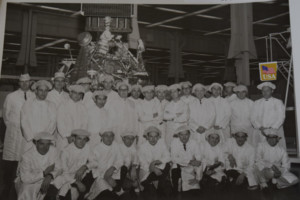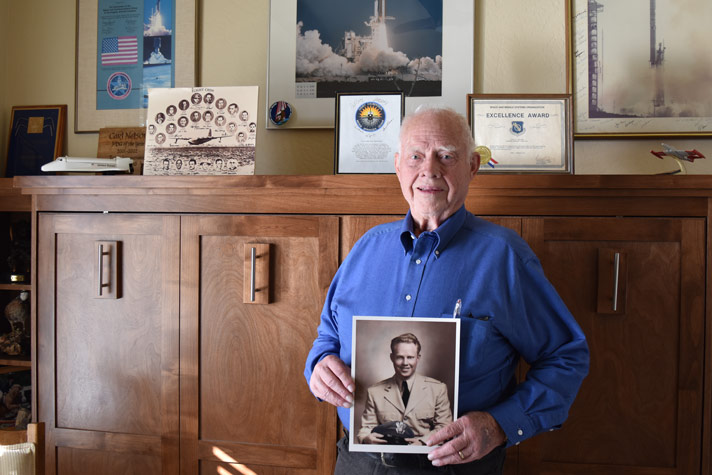Sensational Seniors – December 2017/January 2018
This December “Sensational Seniors” article features well-known and involved former Jacksonville citizen, Carl Nelson, whose 36-year career with Hughes Aircraft is a story in of itself. First, however, it is important to start at the beginning, and in Carl’s case this begins on October 22, 1928 in the remote farming community of Eden, Wyoming. Carl remembers that the family farm, some 35 miles from the city of Rock Springs, had “no electricity, no running water, no telephone, no car and required a three-mile horseback ride to the nearest store and post office. Obviously, we did not have a radio, and I remain amazed at what I have seen and been part of in the development of technology, instantaneous world-wide communications and space flight.”
Carl attended school in Eden; his elementary school took place in a two-room school with grades one to four in one room and five through eight in another. His high school had two teachers with seventeen students in the student body. A talented student, Carl was able to move through high school in three and a half years and at seventeen found himself at the University of Wyoming where he was to graduate with honors in 1950, earning a degree in electrical engineering. Since the University of Wyoming was a Land Grant college, ROTC was a requirement for male students. Carl opted for the Air Force ROTC, a decision that was to make a big difference in his life.
After graduating from college, Carl returned to the family farm for a short time before being offered a job at Boeing in Seattle. So it was off to Seattle he went, but this stay was to last only two months for in February he was called to active duty as part of the Korean War effort. With his second lieutenant commission in hand, Carl was sent to Officer Communications School and then was assigned to a B-29 Squadron as a Communications Officer. In June 1952 he was reassigned to the Far East Material Command in Japan. The Korean War was now raging which resulted in considerable damage to many types of war equipment. This resulted in Carl becoming the Chief Inspector for the repair of electronic equipment being returned to Korea. Carl spent five weeks in North Korea in charge of installing UHF communications ground equipment for the Air Force. While in Japan, Carl had a chance meeting with a Field Service Engineer from Hughes Aircraft; this encounter was to prove pivotal for his eventual career.
Carl’s tour of duty in Japan ended in October 1953 and, as Carl reflects, “I was so fortunate to have been in the Air Force ROTC, for a number of my college friends that were in the Army ROTC were either killed or wounded in Korea.”
When the Korean War ended, so did Carl’s military service and that casual meeting with the Hughes employee led to a call in November 1953 from Hughes, a job offer and the beginning of a 36-year career with the company. Initially hired as a Field Engineer to work with the electronic systems of Fighter Interceptor planes, including the F89D, F94C and F106 models, Carl had a two-year assignment in Newfoundland and a month in Thule, Greenland with the North East Air Defense Command. Carl then ventured into the environmental testing support of the F106, specifically in extreme conditions. One assignment took him to Fairbanks, Alaska and Carl remembers, “When we landed it was 62 degrees below zero. We started flight testing with flights at minus 56 degrees, then minus 48 and minus 42 but then it started warming up, so we came home.” While Carl would have enjoyed more “hands-on” airplane electronics experiences, his leadership skills early on put him into supervisory roles at Hughes.
 Carl’s life took a very positive turn in 1963 when he married “the most beautiful girl in the world.” He and Mary have enjoyed 54 years together, experienced extensive travel throughout the world and raised three children in the process. Shortly after his marriage, Carl’s growing interest in the space industry led him to transfer to the Hughes Space and Communications Group in El Segundo, California. He was to spend the rest of his career there working on various satellite programs. His first satellite was the Surveyor, designed to soft land on the moon. His crew was responsible for the systems integration, systems testing and the launch operations. At the Cape Canaveral launch of Surveyor III, Carl and his crew had the opportunity to insert a piece of thermal blanket into an equipment compartment that had everyone’s signature on it. He was to repeat this with Surveyor VI and is proud of the fact that his signature is on the moon twice. He was to work on many other satellite programs with launches in Cape Canaveral and Vandenberg Air Force Base and was promoted to Program Manager. Hughes Aircraft was a huge operation, which in 1989 had 78,000 employees with 10,000 in the Space and Communications Group.
Carl’s life took a very positive turn in 1963 when he married “the most beautiful girl in the world.” He and Mary have enjoyed 54 years together, experienced extensive travel throughout the world and raised three children in the process. Shortly after his marriage, Carl’s growing interest in the space industry led him to transfer to the Hughes Space and Communications Group in El Segundo, California. He was to spend the rest of his career there working on various satellite programs. His first satellite was the Surveyor, designed to soft land on the moon. His crew was responsible for the systems integration, systems testing and the launch operations. At the Cape Canaveral launch of Surveyor III, Carl and his crew had the opportunity to insert a piece of thermal blanket into an equipment compartment that had everyone’s signature on it. He was to repeat this with Surveyor VI and is proud of the fact that his signature is on the moon twice. He was to work on many other satellite programs with launches in Cape Canaveral and Vandenberg Air Force Base and was promoted to Program Manager. Hughes Aircraft was a huge operation, which in 1989 had 78,000 employees with 10,000 in the Space and Communications Group.
Upon Carl’s retirement from Hughes in 1989, he and Mary took a three-week driving tour of the western states, searching for the ideal retirement community. Friends in Grants Pass led them to discover Jackson County and a drive through Jacksonville and up Livingston Road was the catalyst to choose Southern Oregon as their retirement destination. As Carl puts it, “We saw Livingston Road and it invited us in.” They purchased a home on Livingston and moved in December, 1989. One of the first people Carl and Mary met in Jacksonville was the late Paul Inserra who invited Carl to join the Jacksonville-Applegate Rotary Club and Carl and Mary the Jacksonville Boosters Club. As a result, a new career of volunteerism opened up for Carl and Mary.
They were especially involved in the bi-annual Boosters Historic Home and Garden Tour and Carl, while a late comer to Rotary, really immersed himself in Rotary life, first serving as the club Secretary-Treasurer and then as the Club President of the Jacksonville-Applegate Rotary Club. After that term, he served two years as the Rotary District Secretary before becoming the District 5110 Governor, an all-consuming position that required him and Mary to visit all 63 Rotary Clubs in the District, from Northern California to Corvallis. His International Rotary travels took them to Singapore, Buenos Aires and Victoria, BC. With this busy schedule, Carl even found time to do a two-year teaching stint at Trend Business College in Medford.
Although Mary and Carl have moved from Jacksonville to a new, single-story home in Central Point, his roots are still in Jacksonville, as he remains active in his Jacksonville Rotary Club and the Jacksonville Boosters Club. “Jacksonville,” Carl relates, “is a unique place where people are happy to volunteer to make the town better, where people are genuinely friendly, where we have a multitude of fine restaurants and where we enjoy an active social life.” Carl remains one of the reasons why Jacksonville is such an inviting and welcoming place to live.
